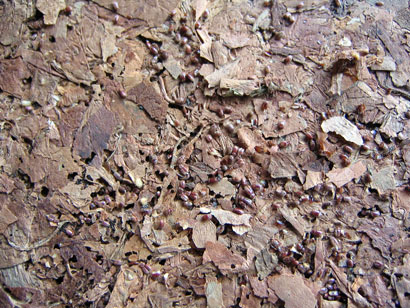Proper pest infestation control remains an essential issue in tobacco warehousing and logistics.
By Stefanie Rossel
Tobacco leaf feels like home to a number of insects, and that continues to be a challenge during transport and storing of the costly base material for combustible cigarettes. In stored raw tobacco, the dreaded cigarette beetle, also known as Lasioderma serricorne, and the similarly destructive tobacco moth (Ephestia elutella) find the perfect conditions to hatch the next generation—or rather, generations as the insects are prolific: In ideal circumstances—for example, in tobacco bales where there are no natural enemies—the female cigarette beetle can produce up to 32 billion descendants per year. The insects thrive in warm and humid warehouse environments in which the larvae feed on dried tobacco, pressed lamina or cut rag, contaminating the commodity with their excretions and thus making it unusable.
The creatures are also hard to extinguish. The design of their respiratory systems allows the beetles to survive a long time with little gas exchange and low levels of oxygen. In each stage of its lifecycle—beetle, egg, larvae, pupae, cocoon—the insect has special characteristics that allow it to survive.
Moth and beetle infestations are responsible for annual losses of between $400 million and $800 million globally, according to industry estimates.
Needless to say, infestation control is essential in the transportation and storage of tobacco. To fight the parasites, Coresta recommends three treatments. An efficient but rarely employed method is freezing the tobacco to below 20 degrees Celsius. The technology is expensive and not apt for handling the high volumes common to cigarette production, hence it is applied only to high-value leaves used for cigars.
According to the fourth edition of Coresta Guide No. 2: Technical Guide for Phosphine Fumigation Parameters for the Control of Cigarette Beetle and Tobacco Moth from August 2019, phosphine gas (PH3), which has been used for decades, is still the main tool for management of infested tobacco. It requires low initial investment and involves low long-term cost. As warehouses can be completely sealed for fumigation, the process allows for high-volume treatment. If protocols are followed, it leaves no chemical residues after the treatment. However, because the treatment isn’t always applied, cigarette beetles are becoming increasingly resistant to phosphine.
The third accepted standard, controlled atmosphere (CA), is a relatively new method in the tobacco industry. While the technology has been in use for more than 100 years for other commodities, it became an option for tobacco infestation control only 15 years ago. The process consists of a specially constructed, gastight chamber in which a commodity is treated in an artificially engineered atmosphere. In the case of infested tobacco, the oxygen level is reduced to below 0.5 percent to ensure a 100 percent mortality rate in all life stages of the insects. While requiring an upfront investment to set up the gastight chamber—which can even be created in a tent—CA offers a number of benefits. Next to the 100 percent mortality guarantee, it can be used for all types and varieties of leaf tobacco without affecting taste and color. Besides, it can be employed for treatment of tobacco products. It is not suitable for high-volume treatment, though.
As with the other methods, procedures must be strictly followed to make CA effective. In 2013, Coresta published its Guide No. 12, which recommended CA technology for infestation control and set up the technical standards for successful use. The guideline, which has been updated several times since its launch, has contributed to the increasing popularity of CA technology. “The industry was already aware of the issues regarding the PH3 resistance of the beetle and was waiting for solutions,” says Rene Luyten, director and owner of b-Cat in the Netherlands. “Since the guideline is out, the market is open for the controlled atmosphere system. Companies who face issues will make the investments in CA.”
B-Cat offers CA systems that can be attached to any hermetically sealed space, such as a storage room, container, silo, tent or bag. The system will then filter out the oxygen inside by using a nitrogen (N2) generator.
Uphill struggle
Of course, the tobacco landscape has changed significantly since 2013. Sales of traditional cigarettes have declined considerably, and many next-generation products are made without leaf tobacco. That development has yet to impact Luyten’s business, however.
“Up to this moment, these changes haven’t had any influences on our market; there is still tobacco, and the cigarette beetle is still present,” he says. “We don’t have an overview if the volumes are getting down. With our system, it’s still a small part of the total volume that is getting treated. We are still building new projects to support our clients with the fight against the PH3-resistant cigarette beetle.”
Luyten notes that demand for CA continues to grow with more companies taking the step using the technology to ensure a clean product and keep the beetle counts down. For b-Cat at this stage, demand for CA is still the highest in Europe, the Middle East and Asia. “It’s not really a fixed region,” says Luyten. “The cigarette beetle travels along with all the movements of the tobacco. We see a slight move from factories to other areas. There is a decrease of infestation in the European Union regions and a move toward [the] Middle East and Asia. For the cigarette beetle, this is a much better climate considering the higher temperatures, so the fight against the beetle isn’t over yet. In the colder climates, the beetle counts aren’t as high as in the warmer climates, but the issue is the same. We notice that between the leaf dealer and clients, the controlled atmosphere isn’t really going on, but at the factory site, which is the last stage, the [number of] projects increase.”
While Luyten is hesitant to put an exact figure on the share of global tobacco production lost to infestation—estimated by some at 1 percent—he says the concern extends beyond the lost volumes. “In the end, it’s all about getting the counts down in the factory and making sure the cigarette beetle will never be found in one of [the] manufacturers’ finished products on the market,” he says.
Luyten is encouraged that customers are increasingly aware of the need to keep their products clean after infestation treatment. “By using controlled atmosphere, we are able to ensure a 100 percent mortality of all life stages of the cigarette beetle, but once that’s performed, we have to protect the materials to keep them clean, something we pushed from the beginning but which wasn’t picked up directly. Nowadays, clients are more aware of this and are more willing to investigate the possibilities.”
Preventing a new invasion
Re-infestation remains an important risk, not only for CA but for all treatments. “Once the treatment is performed, re-infestation is always possible,” says Luyten. “We always discuss this topic with our clients and try to find the best solution in this scenario. Each project is different, and we have to decide whether we will treat the product just before shipment, i.e., export, or whether we treat the incoming product. We also need to assess what the flow of the product is after treatment and in which area the location is—is it colder or in a tropical climate? There are many possibilities on the market, but it always has to be clear that optimum conditions need to be created to avoid re-infestation. Unlike with CA systems, however, a 100 percent mortality rate can’t be guaranteed.”
To help avoid re-infestation after CA treatment, b-Cat’s subsidiary vQm a few years ago developed a method to vacuum-pack tobacco. The technology has since been refined. A patented valve enables flushing the vacuum-packed plastic with N2 or CO2 in a process called modified atmosphere packaging. It ensures insect-free packaging from the moment of packaging to arrival at the end user, according to vQm. Additionally, modified atmosphere packaging reduces oxidation, conserves the product and keeps moisture levels stable.
“VQm packaging is a great solution for cut rag and expanded tobacco,” says Luyten. “Advantages of the method include its effectiveness against insects in all life stages and protection against re-infestation. Furthermore, it enables savings in logistics of at least 25 percent. Weight and moisture loss are minimized, flavor and color preserved, [and] the tobacco freshness is retained. We have a stabilization during shipment and transportation, and the method does not impact tobacco-specific nitrosamines.”
B-Cat has more innovations in the pipeline. “There are always opportunities and improvements to be made—certainly when you think about the complete chain,” says Luyten. “All are related to each other and all are facing the same issue. The purchaser of the leaf is buying hopefully clean products. Many of these products are stored in the warmer climates and not always under the best circumstances. Here is the challenge: how to get the product clean and how to keep it clean from insects before sending it out. The challenge is to be able to ship the materials guaranteed insect-free to the client. However, the sources are limited, and there are many factors which have an influence.”

Stefanie Rossel is Tobacco Reporter’s editorial contributor.
An experienced trade journalist, she combines sharp reporting skills with in-depth knowledge of the tobacco and vapor industries.
Prior to joining Tobacco Reporter, Stefanie was editor-in-chief at Tobacco Journal International, where she worked for a decade.
Fluent in English, German and French, Stefanie covers tobacco news around the world. She is based in Germany.


